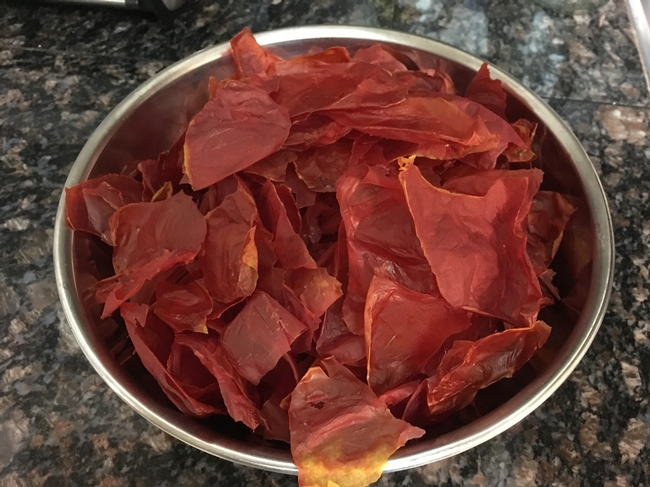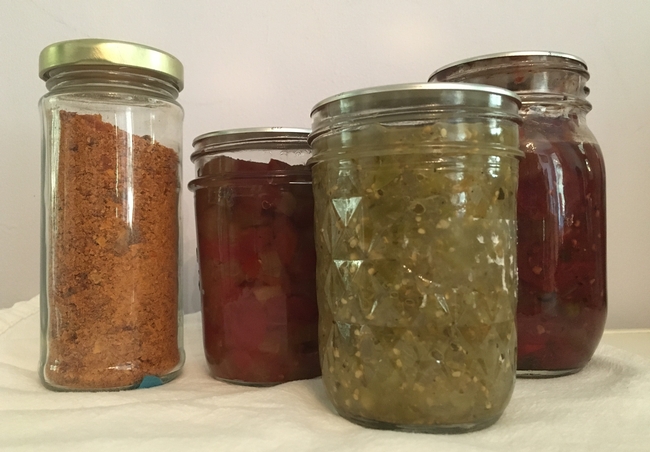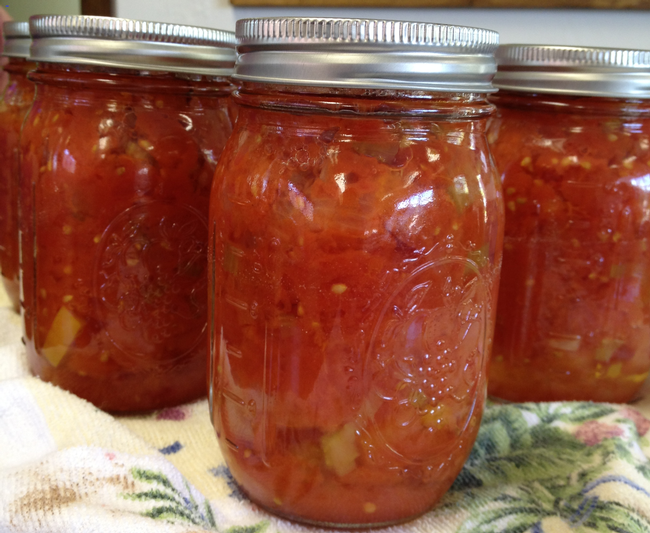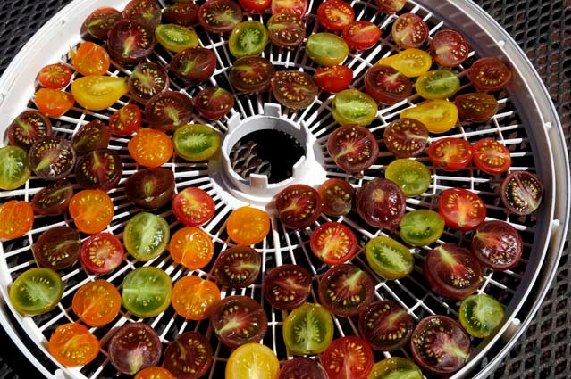If you also found a silver lining to staying/working at home this summer by planting and tending to your garden, did your wish for a bumper crop of tomatoes come true? What happens if your tomato plants are prolific producers?
Preserve those tomatoes!
The easiest way to preserve tomatoes is to freeze them. You don't need to blanch them, you don't need to peel them. Just rinse, dry, core, and put them on a small tray or plate in the freezer. Once frozen solid, move them to a freezer bag, removing as much air from the bag as possible before closing. Pull the bag out of the freezer when you're ready to use the tomatoes. To peel, let them thaw just a little and then run each tomato under warm water to slip off the skins. It's that easy. (They won't have the texture of a fresh tomato, but they'll be perfect to make a fresh sauce for dinner.)
Don't throw away those skins! Or soft tomatoes. If you have a dehydrator, lay tomato skins on the tray, sprinkle with your favorite spice mix (garlic salt works well), and dry until crispy to make a tomato skin chip. Some heirloom tomato skins are bursting with flavor. Or instead of making chips, toss tomato skins and soft tomatoes into a freezer bag until you fill the bag. Thaw and puree the bag's contents and dry the mixture on your dehydrator tray as a crisp leather. Grind up the leather to make a tomato powder to use for camping soup mixes and dehydrated salsa mix. Sprinkle tomato powder on scrambled eggs for tomato flavor without the extra moisture or add to meatloaf, burgers or soups to enhance flavor. Get creative!
If you're a canner, there are lots of options. Many people don't think of tomatoes as a basis for jam or jelly, but with the right spices and some sugar, the flavor profile changes significantly. I served Spiced Tomato Jam in a blind taste test with third-graders a few years ago and they guessed it was apple pie and pumpkin pie because of the nutmeg, cinnamon and allspice. It's delicious!
A family favorite is Tomato Apple Chutney. This savory spread is a collection of tomatoes, apples, onions, raisins, garlic, cucumber, red bell peppers, a little sugar and spices. I like to mix it with mayonnaise for a sandwich spread. The first time I made it my husband and I ate sandwiches for lunch and dinner three days in a row. It is one of the first red tomato products I can each summer.
Another family favorite is Roasted Eggplant and Pepper Puttanesca Sauce. The combination of roasted plum tomatoes, eggplant, onions and red peppers with capers, olives, spices, balsamic vinegar and wine make a chunky pasta sauce that smells fabulous when you open the jar. I usually make 3-4 batches and enjoy them all year.
My pantry staple is plain crushed tomatoes. I add spices when I make a meal, cooking them down, adding tomato paste (remember the tomato powder?) and dried veggies. Each jar of crushed tomatoes can become part of a unique meal. The main thing to remember is to add acid to each jar before filling it to ensure there's enough acidity to make the tomatoes a high acid food and safe to can in a steam canner or boiling water canner. I normally use bottled lemon juice, but this year I'm trying a few jars with cider vinegar; rumor has it that after being stored for several months the vinegar flavor mellows and enhances the flavor. I'll label the jars to identify the acid used.
I learned a great tip at one of our public classes a couple of years ago. Often when canning tomatoes, there's watery liquid at the bottom of the cook pot. Don't throw out the tomato water! You can jar and process it with the rest of your crushed tomatoes. Use the tomato water to cook couscous, quinoa, rice or as the liquid in a soup.
This is the first year I've actually put my garden in on time and shouldn't have plants loaded with green tomatoes right before the first freeze. If I do, I'll be thrilled because I'll make Green Tomato Salsa Verde – it's delicious! (It ranks up there with Tomatillo Salsa; I've already made three double batches and plan to make more.) Green tomatoes are more acidic than ripened tomatoes and you can use them in place of red tomatoes in any canning recipe, following standard acidification methods.
I just picked a cherry tomato off the potted plant on my back patio that is purposely within easy snacking distance from my kitchen. If I get too many to eat within a couple of days I'll cut them in half and dehydrate them. The result is as good as candy.
So many tomato possibilities! If you want more ideas, contact the UC Master Food Preserver online help line at Ask a Master Food Preserver.
Visit our website at http://mfp.ucanr.edu/to watch a variety of preservation videos from Cooperative Extension offices around the country, explore recipes, and find out more about the UC Master Food Preserver Program.



